Exploring the historic heart of Split has never been more captivating. The Private History Split Walking Tour in English takes visitors on a deep dive into the UNESCO World Heritage site of Diocletian’s Palace. Led by knowledgeable guides, this immersive experience unveils the architectural brilliance and imperial legacy of this remarkable Roman-era structure. From the central square to the palace substructures, guests uncover the ingenuity and vision that shaped this captivating gem. Prepare to be transported back in time as you discover the vibrant atmosphere and rich history that make Split’s old town a must-see destination.
Key Points
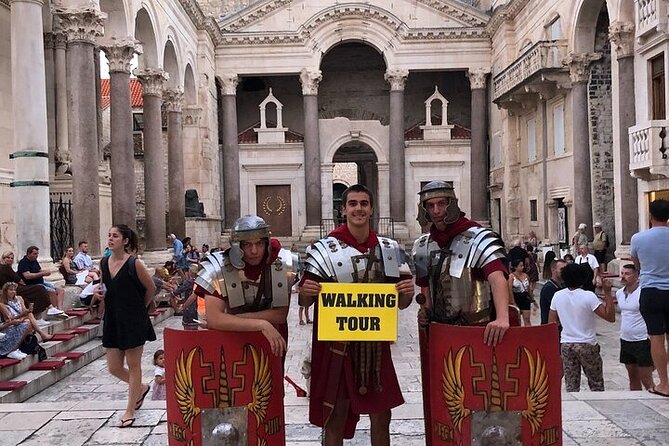
- Discover the rich history and UNESCO World Heritage site of Diocletian’s Palace in Split, Croatia on a private walking tour led by an educated guide.
- Explore the grand imperial architecture, including the Peristil square, Vestibulum, and subterranean vaults, and learn about the palace’s construction and function.
- Admire the iconic Golden Gate, a masterpiece of Roman engineering, and the statue of Gregory of Nin, a symbol of Croatia’s cultural identity.
- Gain a deeper appreciation for the ingenuity and vision that created this remarkable historical site through the knowledgeable guidance of your tour expert.
- Experience the vibrant atmosphere of Split’s old town as you explore the captivating stories and insights about Emperor Diocletian’s legacy.
Overview of the Tour
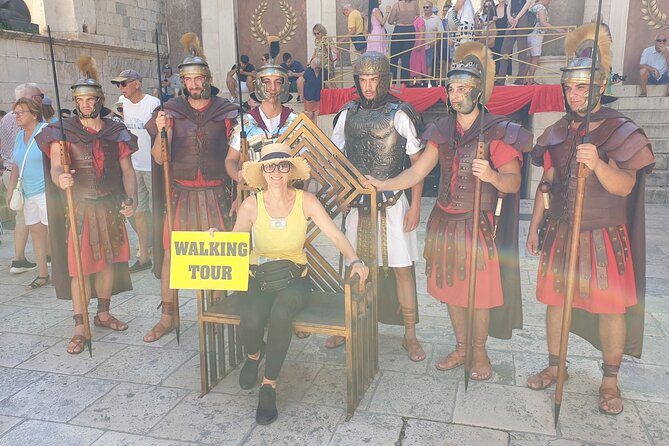
The Private History Split Walking Tour in English allows visitors to discover the rich history of Split, Croatia and the UNESCO World Heritage site of Diocletian’s Palace.
Led by an educated guide with great knowledge of the locations around the palace, the tour will take you on a journey through the central square, the historic Vestibulum, and the substructures of the palace.
You’ll learn about the construction and function of these impressive structures, as well as the history of Emperor Diocletian.
Along the way, you’ll see the iconic Golden Gate and the statue of Gregory of Nin, gaining a deeper understanding of Split’s captivating past.
Want to keep it personal? More private experiences we love in Split
Diocletian’s Palace: A UNESCO Gem
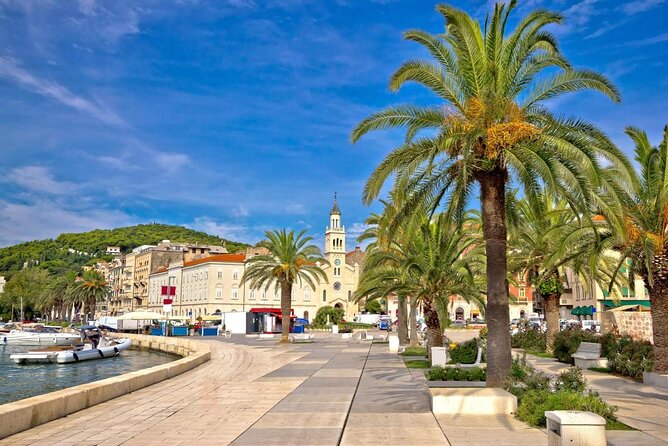
Diocletian’s Palace stands as a remarkable UNESCO World Heritage Site, showcasing the architectural brilliance and rich history of its Roman origins.
Constructed in the late 3rd century AD as the retirement residence for Roman Emperor Diocletian, this sprawling complex blends grand imperial design with the vibrant daily life of Split’s old town.
As you explore the palace, you’ll marvel at the impressive stone structures, such as the towering Golden Gate and the subterranean vaults.
The central Peristil square, once the heart of the palace, is now a lively gathering place where you can soak up the atmosphere and imagine the bustling activity that once filled these halls.
This UNESCO gem offers a unique window into Split’s past.
Exploring the Central Square
At the heart of Diocletian’s Palace lies the captivating Peristil square, where visitors can enjoy the vibrant history and atmosphere of Split’s old town. Flanked by impressive columns and towering structures, this central gathering place offers a glimpse into the daily life that once bustled within the palace walls.
As you wander through the square, you’ll be drawn to the striking vestibulum, a majestic entrance that once welcomed Diocletian himself. Nearby, the towering Golden Gate stands as a testament to the palace’s architectural grandeur. To truly appreciate the square’s significance, be sure to explore the underground substructures, which offer a unique perspective on the palace’s construction and functionality.
| Feature | Description |
|---|---|
| Peristil Square | Central gathering place of Diocletian’s Palace |
| Vestibulum | Majestic entrance that once welcomed Diocletian |
| Golden Gate | Impressive architectural feature showcasing the palace’s grandeur |
| Substructures | Fascinating underground structures that reveal insights into the palace’s construction |
Vestibulum: The Historic Entry
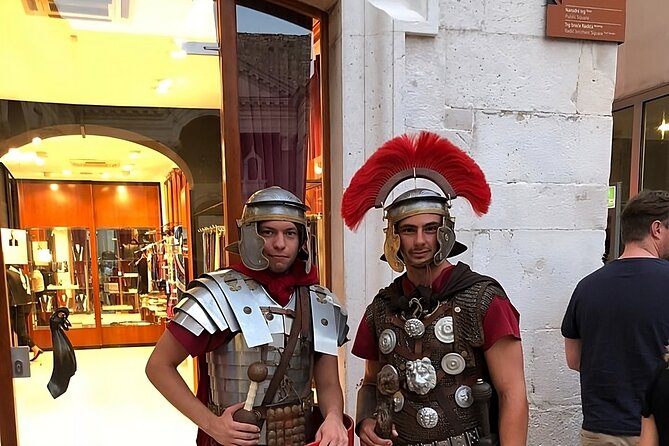
As visitors step into the Peristil square, they can’t help but be drawn to the majestic Vestibulum – the historic entry point that once welcomed the mighty Emperor Diocletian himself.
This grand entrance pavilion was the ceremonial gateway into the palace complex, where Diocletian would make his grand entrances.
Today, visitors can marvel at its impressive architecture, with its high ceilings and ornate decorations.
The Vestibulum’s design reflects the power and grandeur of the Roman Empire, and it’s easy to imagine the pomp and circumstance that would have accompanied an imperial procession through these hallowed halls.
It’s a truly awe-inspiring sight that transports you back in time to the glory days of ancient Split.
Discovering the Palace Substructures
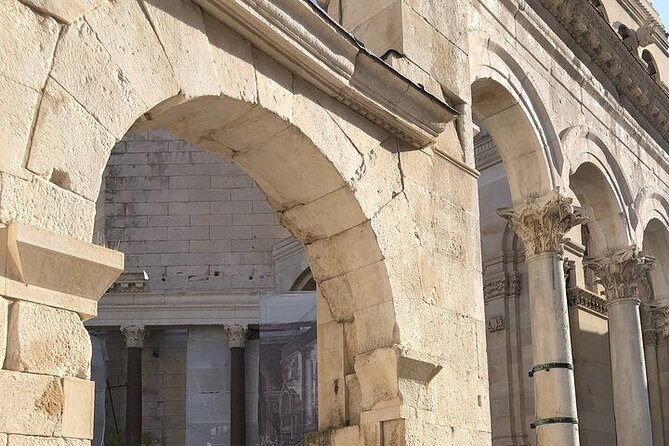
Venturing beneath the grand halls of Diocletian’s Palace, visitors uncover a hidden world – the intricate substructures that once supported the imperial residence above.
These remarkably preserved cellars and passages offer a fascinating glimpse into the engineering marvels of ancient Roman architecture.
As the tour guide leads the way, guests are captivated by the sheer size and complexity of these underground chambers.
They learn how these vaulted spaces were designed to provide a stable foundation and facilitate the flow of goods, services, and people within the palace.
Exploring the substructures, visitors gain a deeper appreciation for the ingenuity and vision that went into creating this UNESCO World Heritage Site.
If you're enjoying exploring Split on foot, you'll love these other walking tours we recommend
The Grandeur of the Golden Gate
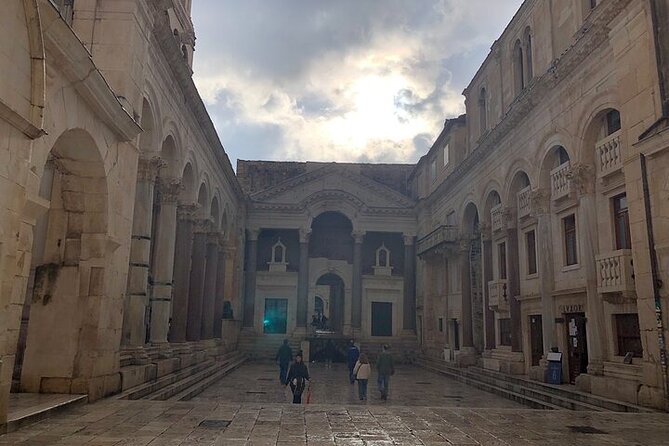
Towering above the bustling streets of Split, the Golden Gate of Diocletian’s Palace stands as an iconic symbol of the city’s rich Roman heritage. Adorned with intricate carvings and majestic columns, this grand entryway once served as the principal access point for the emperor and his entourage, welcoming them into the heart of the imperial residence.
| Feature | Description |
|---|---|
| Architecture | The gate’s design is a masterpiece of Roman engineering, featuring a central arch flanked by two smaller side arches. |
| Symbolism | The ornate sculptures and reliefs adorning the gate represent the power and grandeur of the Roman Empire. |
| Historical Significance | As the main entrance to the palace, the Golden Gate witnessed the comings and goings of emperors, nobility, and visitors throughout the centuries. |
Today, the Golden Gate continues to captivate visitors, inviting them to step back in time and imagine the grandeur of Diocletian’s world.
Statue of Gregory of Nin
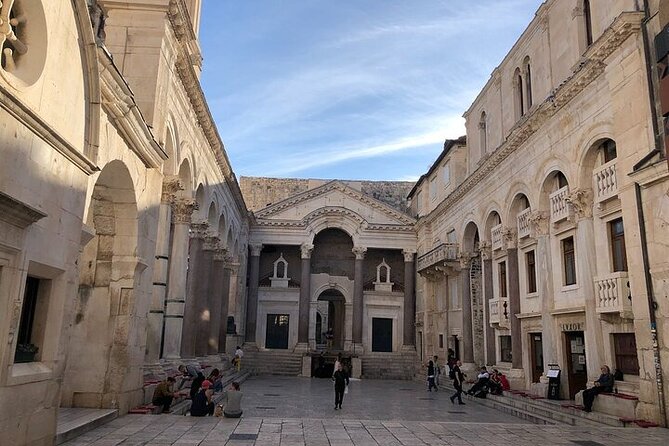
Just steps from the majestic Golden Gate stands a prominent statue that pays tribute to a pivotal figure in Split’s history – Gregory of Nin.
This larger-than-life bronze statue depicts Gregory, a 10th-century Croatian bishop who fought for the use of the Croatian language in Catholic church services.
Tourists flock to rub the big toe of the statue, as it’s said to bring good luck.
The statue, sculpted by renowned Croatian artist Ivan Meštrović, serves as a symbol of Croatia’s fight for independence and the preservation of its cultural identity.
As you wander through the historic Diocletian’s Palace, be sure to stop and admire this striking monument to a true Croatian hero.
Private and Knowledgeable Guidance
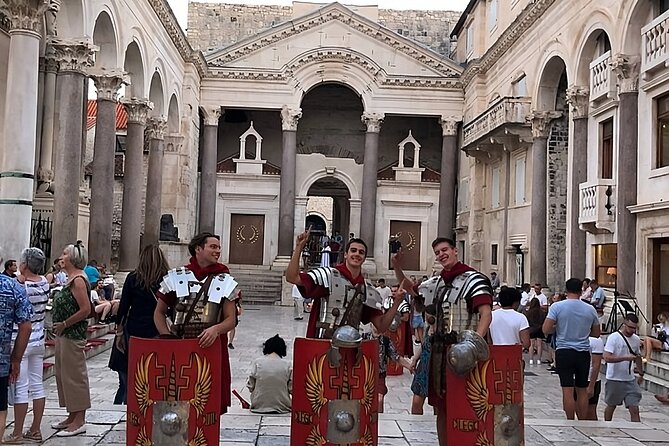
The private walking tour in Split offers visitors a knowledgeable guide who brings the rich history of the city and Diocletian’s Palace to life.
With expertise and passion, the guide navigates guests through the UNESCO World Heritage site, sharing captivating stories and insights that illuminate the palace’s remarkable architecture and significance.
Guests can expect an engaging and informative experience as the guide delves into the intriguing details of Emperor Diocletian’s legacy.
From exploring the substructures to discussing the symbolic Golden Gate, the guide weaves together a comprehensive understanding of Split’s past, ensuring travelers leave with a deeper appreciation for the cultural and historical treasures within Diocletian’s Palace.
Frequently Asked Questions
How Long Does the Walking Tour Typically Last?
The walking tour typically lasts around 2 hours. It provides an in-depth exploration of the Diocletian’s Palace and the city’s rich history, allowing guests to discover the highlights at a leisurely pace.
Is the Tour Wheelchair Accessible?
The tour is generally wheelchair accessible, as the main areas of Diocletian’s Palace have level paths and gentle slopes. However, visitors should note that some parts of the substructures may have steps or uneven terrain.
Can the Tour Be Customized to Our Interests?
Yes, the tour can be customized to your interests. The private nature of the experience allows the guide to tailor the content and focus based on what you’d like to learn more about during your time in Split.
What Is the Cancellation Policy for the Tour?
The tour has a flexible cancellation policy – guests can cancel up to 24 hours before the start time for a full refund. This allows travellers to change their plans without penalty if needed.
Can We Take Photographs During the Tour?
Absolutely, guests are encouraged to take photographs throughout the tour. The guide will provide opportunities to capture the stunning architecture and historical sights that are explored. Photography is a great way to document the experience.
Recap
The Private History Split Walking Tour offers an unparalleled opportunity to explore the captivating history and architectural splendor of Diocletian’s Palace.
With expert guidance, visitors can enjoy the vibrant atmosphere of Split’s old town, gaining a deep appreciation for the ingenuity and vision that created this UNESCO World Heritage site.
It’s a must-do experience for anyone seeking to uncover the rich tapestry of Dalmatia’s Roman heritage.
More Walking Tours in Split
More Tours in Split
More Tour Reviews in Split
Not for you? Here's more things to do in Split we have recnetly reviewed
- History Walking Group Tour in Split
- Private Tour Krka National Park Waterfalls from Split
- Private Adventure: 6 Islands & Blue Cave Boat Tour
- Private Boat Tour with Customized Itinerary from Split
- Split: All Inclusive,Underwater Museum,Trogir, Blue Lagoon
- Open Panoramic Bus Tour +Guided Walking Tour in 10 languages
- Split: Blue Lagoon and 3 Islands Tour
- From Split: Cetina Family Quad Tour with Picnic
- Split: Sunset Guided Kayaking Tour
- Split: Sunset Boat Party with Live DJs and Blue Lagoon Swim
- Split: Guided Sea Kayaking Tour with Snorkeling
- Split: Blue Lagoon and 3 Island Cruise with Food and Drinks
